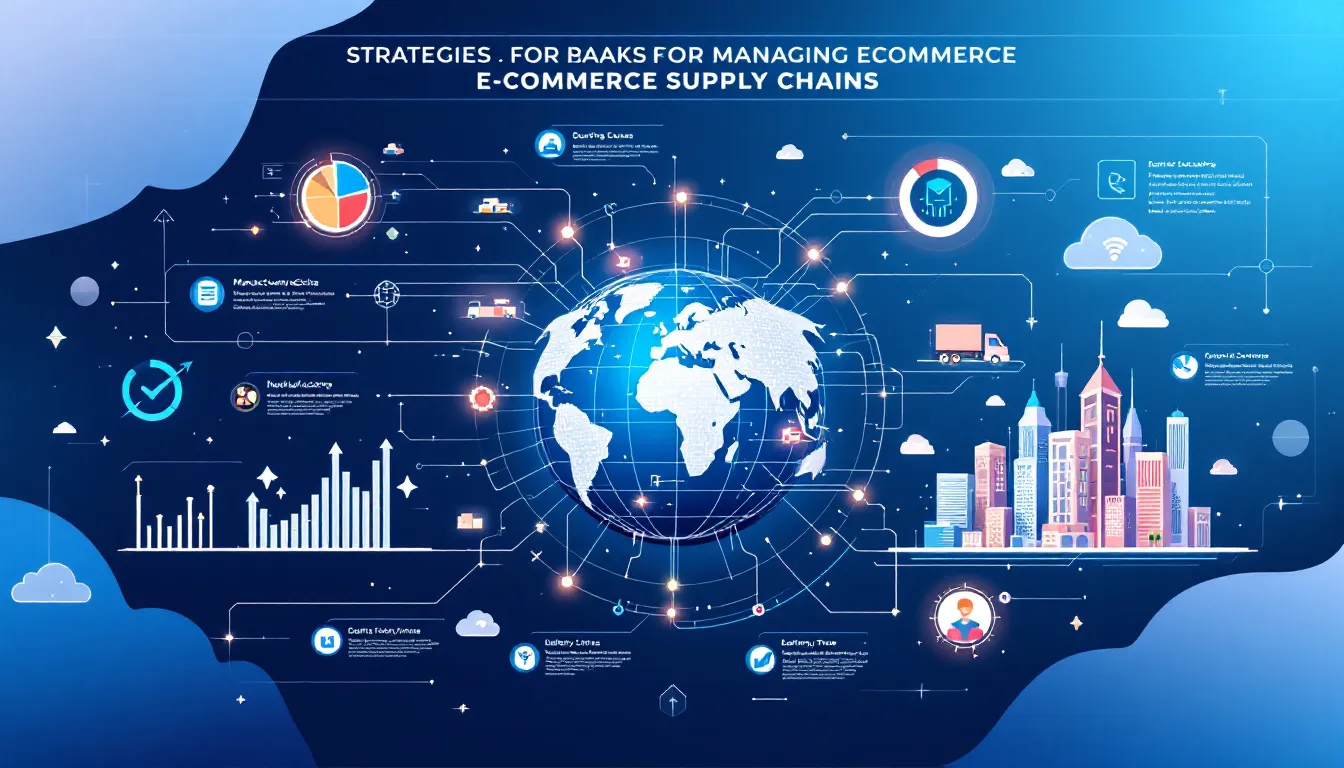Effective supply chain management in ecommerce is vital for timely deliveries and cost efficiency. This article delves into the essential components, strategies, benefits, and technologies of supply chain management ecommerce.
What is an Ecommerce Supply Chain?

An ecommerce supply chain is a dynamic and interconnected network of processes and entities responsible for the production, warehousing, multi-echelon inventory management, order fulfillment, and distribution of goods in an online retail environment. It encompasses everything from sourcing raw materials to delivering the final product to the customer’s doorstep.
Effective ecommerce supply chain management ensures that these processes are seamlessly integrated, enabling businesses to meet consumer demands efficiently and achieve high levels of customer satisfaction. By optimizing each stage of the supply chain, companies can enhance operational efficiency, reduce costs, and deliver a superior customer experience.
The ecommerce supply chain is a carefully coordinated series of processes that begins with production and concludes with the delivery of customer orders within commerce supply chain management.
This comprehensive process includes:
- production
- manufacturing
- warehouse management
- inventory storage
- order fulfillment
- shipping
Each stage is crucial for maintaining efficiency and a seamless transition from order to delivery. It is important when we talk about business expansion for example german market entry while selling supplements online or selling toys.
Supply chain management entails managing the logistics for finished goods. This includes both in-bound shipments from production and outbound logistics for shipping customer orders. Effective ecommerce supply chain management ensures that materials, products, money, and information flow smoothly and efficiently, ultimately driving customer satisfaction and operational success.
Any type of warehouse, acting as the nerve center, plays a crucial role in managing and storing inventory until it is ready for delivery. Clearly, each stage of the ecommerce supply chain is invaluable for running a successful business.
Key Elements of Ecommerce Supply Chain Management

Inventory Management
- Balance stock control and distribution management to avoid overstocking and stockouts.
- Enhance visibility into stock levels and locations, aligning inventory with consumer demand.
Warehouse Management System (WMS)
- Simplifies tracking of inventory levels and distribution channels.
- Oversees warehousing operations, ensuring efficient storage and quick retrieval of products.
Order Management System (OMS)
- Streamlines the lifecycle of customer orders.
- Provides real-time insights to facilitate smooth operations.
Collaboration of Systems
- Inventory and warehouse management systems work together to:
- Optimize storage.
- Monitor inventory movement.
- Streamline fulfillment.
- Optimize last and first mile delivery.
These systems form the bedrock of supply chain efficiency, enabling ecommerce businesses to meet customer expectations and operate optimally.
Benefits of Effective Ecommerce Supply Chain Management

A reliable ecommerce supply chain is the cornerstone of customer satisfaction and operational success. Streamlining these processes can significantly improve internal operations, reduce costs, and enhance the overall customer experience. The benefits of an optimized supply chain are manifold, driving efficiency across multiple fronts and fostering improved customer relationships.
Here are some specific advantages of effective ecommerce supply chain management.
Faster Delivery Times
In the fast-paced world of ecommerce, speedy delivery is a must-have, with around 90% of online shoppers expecting their purchases within 2 to 3 days. Fast shipping reduces cart abandonment rates, giving businesses a competitive edge. By strategically planning delivery routes and utilizing multiple fulfillment centers, companies can significantly cut down delivery times and conserve resources. Timely deliveries are crucial for boosting customer satisfaction and fostering loyalty.
Optimizing delivery routes ensures packages arrive on time, enhancing customer satisfaction. Using multiple fulfillment centers shortens delivery distances, contributing to faster delivery times. These strategies not only improve the customer experience but also help businesses stay competitive in the market.
Cost Reduction Strategies
Effective supply chain management is pivotal for identifying cost savings and boosting profitability.
Optimize Transportation
One of the most impactful supply chain management strategies is optimizing transportation, which involves using appropriate packaging, splitting inventory across locations, obtaining shipping discounts, and implementing last mile delivery tracking. For instance, AGCO implemented a globally integrated transport management system, achieving freight cost reductions of 18% and increasing network performance by 25%. Similarly, Intel’s transition to a make-to-order model cut its Atom chip supply chain costs significantly, reducing the order cycle time from nine weeks to just two.
Leverage Automation and Analytics
Other strategies include leveraging automation and analytics tools to enhance decision-making and reduce operational costs. Starbucks, for example, restructured its supply chain operations, saving over $500 million by managing logistics partners more effectively and increasing production capabilities.
Analyze Competitor Pricing
Analyzing competitor pricing and consumer responses also allows for dynamic price adjustments to maximize profits. These cost reduction strategies collectively contribute to a more efficient and profitable supply chain.
Enhanced Inventory Accuracy
Accurate inventory management is vital for ecommerce supply chains, preventing stockouts and optimizing stock levels. It relies on demand forecasting and real-time inventory software to enhance decision-making. Key strategies include setting reorder points and conducting audits to maintain inventory accuracy.
Strong Supplier Relationships
Strong supplier relationships are essential for reliable stock replenishment. For instance, Sunsweet Growers improved forecasting accuracy by 15-20% and lowered production costs by reducing warehouses. Efficient inventory visibility aids in forecasting stock levels, enhancing inventory management.
Importance of Automation
Manual inventory management often leads to inaccuracies, highlighting the importance of automated systems.
Strategies for Managing Ecommerce Supply Chains

Managing ecommerce supply chains effectively requires a blend of strategic planning and technological implementation. From utilizing multiple fulfillment centers to implementing real-time inventory management tools, there are several strategies that can enhance supply chain efficiency.
Let’s explore these strategies in more detail.
Utilizing Multiple Fulfillment Centers
Utilizing multiple fulfillment centers allows businesses to minimize shipping times by shortening delivery distances. Storing inventory in multiple locations reduces shipping costs by shortening average shipping zones. This strategy brings significant cost savings by enabling businesses to ship from the nearest locations to customers. Automating order processing further reduces lead time and expedites shipping tasks.
Third-party logistics (3PL) services can also be leveraged to reduce costs and transit times, resulting in improved delivery performance. For instance, WAPI assists merchants by providing a network of fulfillment centers and a dashboard for tracking inventory and orders. Utilizing third-party logistics providers allows businesses to outsource shipping and order fulfillment, reducing management hassles.
Implementing Real-time Inventory Management Tools
Real-time inventory management tools prevent stock shortages and enhance logistics efficiency. Automated warehouse picking systems offer real-time tracking, reducing errors and overstocking. Data analytics provides insights for optimizing performance, supporting accurate stock assessments and timely reordering.
Optimizing Warehouse Operations
Implementing a warehouse management system can provide better visibility into inventory and improve order accuracy. Transparency regarding storage space, including warehouse capacity and current orders, is a primary benefit of warehouse management systems. Automated order processing enhances operational efficiency, reducing lead times.
Monitoring inventory movement can enhance fulfillment processes and streamline warehouse operations. For example, Terex transitioned to an RFID tracking system for yard management, reducing inventory location time from six minutes to 30 seconds per unit.
Implementing a Transport Management System (TMS) can further enhance shipment visibility and reduce damages during transit.
Overcoming Common Ecommerce Supply Chain Challenges

Ecommerce supply chains face several challenges, including transportation logistics complexities, handling returns, and maintaining customer satisfaction. Delays can be caused by various factors such as delayed shipments, holdups in manufacturing, and stockouts.
Addressing these challenges is crucial for maintaining a responsive and efficient supply chain.
Handling Transportation Logistics
Transportation logistics in ecommerce involves managing delivery times and ensuring safe product delivery. Real-time tracking enhances delivery transparency, boosting customer satisfaction. Managing diverse carriers and locations complicates freight management, making effective logistics crucial for timely deliveries. By leveraging real-time tracking and efficient freight management systems, businesses can overcome these logistics challenges, enhancing overall supply chain efficiency.
Managing Returns and Reverse Logistics
Efficient reverse logistics processes are vital for managing returns and boosting customer satisfaction. By streamlining reverse logistics, businesses can simplify the returns process and recover value from returned items, which is crucial for maintaining brand reputation and enhancing customer experiences. Implementing clear return policies and optimizing return handling are essential steps to minimize losses and ensure a cost-effective supply chain.
Technology in Ecommerce Supply Chains 2025

Technology plays a pivotal role in enhancing the efficiency of ecommerce supply chains. Advancements such as AI, blockchain, and IoT have revolutionized supply chain management by improving communication and information transfer.
Let’s delve into how leveraging automation and data analytics can drive supply chain efficiency.
Leveraging Automation for Efficiency
Automation in warehouse tasks reduces labor costs, minimizes human error, and boosts productivity. Around 70% of businesses are adopting automation to enhance inventory management and reduce human error. Cost-effective alternatives like gloves with screens and scanners for barcode identification are being implemented for automation in warehouses.
Automating manual tasks in the supply chain is crucial for increasing productivity and minimizing errors. These automated systems provide real-time insights that support accurate inventory management and operational efficiency, ultimately reducing costs and enhancing overall supply chain performance.
Using Data Analytics for Better Decision-Making
Data analytics provides critical insights that drive strategic supply chain decisions and optimize performance. Leveraging data analytics allows companies to identify trends, forecast demand, and respond proactively to market changes. Analyzing data from various sources enables businesses to make informed decisions that enhance supply chain efficiency and effectiveness.
Real-time inventory management tools, enhanced by data analytics, support accurate stock level assessments and timely reordering, improving overall efficiency. These tools enable businesses to generate real-time insights, providing a competitive advantage in managing inventory and meeting customer demands. Effective use of data analytics ensures that supply chain operations are aligned with market needs, driving business growth.
Ecommerce Supply Chain Models

The ecommerce supply chain encompasses various logistics processes, including procurement, manufacturing, warehousing, fulfillment, inventory management, and last-mile delivery. Understanding these stages is essential for designing an effective supply chain tailored to specific business models.
Dropshipping
Dropshipping is a model that allows ecommerce businesses to operate without holding inventory. Instead, products are shipped directly from suppliers to customers. This approach reduces overhead costs and minimizes the risk associated with unsold stock. By not needing to manage inventory, businesses can focus more on marketing and customer service.
Fulfillment by Amazon (FBA)
Fulfillment by Amazon (FBA) is a popular model where sellers leverage Amazon’s extensive logistics network for storage, packaging, and shipping of their products. This service simplifies order fulfillment and allows sellers to reach a wider audience.
Benefits of FBA
- Streamlined Logistics: Amazon handles the entire logistics process, from warehousing to shipping, allowing sellers to focus on growing their business.
- Prime Eligibility: Products fulfilled by Amazon are eligible for Amazon Prime, providing faster delivery options to customers and potentially increasing sales.
- Customer Service: Amazon manages customer service and returns, reducing the operational burden on sellers.
Challenges of FBA
- Fees: While FBA offers numerous advantages, it comes with fees for storage and fulfillment, which can impact profit margins.
- Inventory Management: Sellers need to carefully manage inventory levels to avoid long-term storage fees and ensure product availability.
Direct-to-Consumer (DTC)
The Direct-to-Consumer (DTC) model enables brands to sell directly to customers, bypassing traditional retail channels. This approach provides brands with complete control over customer interactions and higher profit margins. By owning the customer relationship, brands can gather valuable insights and tailor marketing strategies to improve customer experiences.
Subscription-Based Selling
Subscription-based selling creates predictable revenue streams through recurring orders. This model enhances customer loyalty and ensures steady cash flow by providing customers with regular deliveries of products with appropriate courier services they need or enjoy. Businesses can leverage this model to build long-term relationships with customers and encourage repeat purchases.
Third-Party Logistics (3PL) / Fulfillment

Third-party logistics (3PL) is a model where ecommerce businesses outsource various supply chain operations to external service providers. This includes warehousing, inventory management, order fulfillment, and shipping. By leveraging 3PL services, businesses can focus on core activities such as marketing and product development, while the logistics experts handle the operational complexities.
Benefits of 3PL
- Cost Efficiency: Outsourcing logistics can reduce operational costs by eliminating the need for businesses to invest in their own warehousing and fulfillment infrastructure. 3PL providers often have established networks and can offer economies of scale.
- Scalability: 3PL logistics services are highly scalable, allowing businesses to easily adjust to fluctuations in demand without the hassle of expanding or downsizing their logistics operations.
- Expertise and Technology: 3PL providers bring specialized knowledge and advanced technology, such as inventory management software and real-time tracking systems, which enhance supply chain efficiency and accuracy.
- Focus on Core Competencies: By delegating logistics tasks to 3PL providers, businesses can concentrate on their core competencies, such as product innovation and customer service, leading to improved overall performance.
Challenges of 3PL
- Loss of Control: Outsourcing logistics can lead to reduced control over certain aspects of the supply chain, which may impact the ability to quickly respond to issues or changes in customer demand.
- Dependency on Providers: Relying heavily on 3PL providers can create dependency, making it crucial to choose reliable partners and maintain strong communication channels.
- Integration Challenges: Ensuring seamless integration between the business’s systems and the 3PL provider’s technology can be complex and may require significant effort and resources.
Overall, the 3PL model offers significant advantages for ecommerce businesses looking to streamline their supply chain operations and enhance efficiency. By carefully selecting and collaborating with the right 3PL partners, businesses can overcome potential challenges and reap the benefits of this model.
Summary
The journey through effective ecommerce supply chain management reveals the critical role it plays in achieving customer satisfaction and operational success. From understanding the core elements and benefits to exploring strategies and overcoming challenges, the insights provided are invaluable for optimizing supply chain processes. Implementing technologies like automation and data analytics further enhances efficiency, ensuring that businesses can meet customer demands swiftly and accurately, increasing it’s own GMROI and other indicators.
In conclusion, a well-managed ecommerce supply chain is the backbone of a successful ecommerce business. By leveraging the strategies and tools discussed, businesses can reduce costs, improve delivery times, and maintain accurate inventory levels. As the ecommerce landscape continues to evolve, staying ahead of supply chain challenges and embracing technological advancements will be key to sustaining growth and competitiveness.
Frequently Asked Questions
What are the key components of an ecommerce supply chain?
The key components of an ecommerce supply chain are production, warehousing, inventory management, order fulfillment, and shipping. Each plays a crucial role in ensuring efficient delivery and customer satisfaction.
How can I reduce costs in my ecommerce supply chain?
To effectively reduce costs in your e-commerce supply chain, focus on implementing automation and optimizing transportation, while also leveraging advanced inventory management tools for better efficiency.
Why is accurate inventory management important?
Accurate inventory management is essential as it prevents stockouts, optimizes stock levels, and ensures timely reordering, all of which are vital for maintaining customer satisfaction. This directly impacts business efficiency and profitability.
What are the benefits of using multiple fulfillment centers?
Utilizing multiple fulfillment centers significantly enhances your logistics efficiency by minimizing delivery times and reducing shipping costs, as products can be dispatched from the nearest locations to customers. This strategic distribution ultimately leads to improved customer satisfaction and potentially increased sales.
How does technology enhance ecommerce supply chain management?
Technology significantly enhances ecommerce supply chain management by improving communication, reducing costs, and facilitating real-time inventory tracking, which leads to better decision-making. Embracing these technological advancements is crucial for optimizing efficiency and effectiveness in supply chain operations.



 Community
Community
